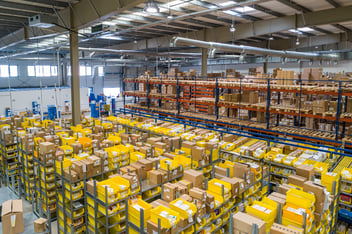Why U.S. Consumer Brands Are Shifting U.S.-Bound Product Inventory to Canada Amid Soaring Tariffs
With U.S. tariffs on Chinese imports at historic highs, U.S. consumer brands are changing their fulfillment strategy: near-shoring to Canadian warehouses, handling Canadian fulfillment in country, and gradually feeding inventory into the U.S. based on customer demand.
For board game publishers and consumer product brands manufacturing in China, recent developments in U.S. trade policy have sparked a wave of uncertainty—and forced many to rethink their supply chain strategy.
On March 4, 2025, the U.S. government enacted new tariff rules that dramatically increase the cost of importing Chinese-manufactured goods into the country. Products falling under HS Code 9504.90.6000 —which includes board games, toys, and similar consumer packaged goods—are now subject to a cumulative 145% tariff upon entry into the U.S.
For many importers, this change means more than just a higher duty—it threatens their profitability, pricing models, and market competitiveness. And although the tariffs do not apply to shipments already in transit as of March 4 or inventory already landed in the U.S., any upcoming import plans from China must now contend with this dramatic new cost structure.
The Dilemma: Wait, Pay, or Pivot?
Faced with the sudden tariff spike, U.S.-based publishers and brand owners have been left with three primary paths forward—each with its own drawbacks:
1. Pause Manufacturing
Some companies are choosing to halt production altogether, hoping the political and economic landscape will stabilize. While this might avoid costly tariffs in the short term, it comes at a steep price:
- Cash flow interruptions due to delayed inventory turnover.
- Disrupted release schedules, which can negatively affect crowdfunding campaigns, seasonal launches, and retailer relationships.
- Customer dissatisfaction, particularly from crowdfunding backers and pre-order customers expecting timely fulfillment.
2. Hold Inventory in China
Others are opting to store finished goods at the factory or in nearby Chinese facilities. While this avoids immediate tariffs, it creates several operational headaches:
- Accumulating storage fees, often at premium rates as inventory piles up.
- Warehouse congestion at the factory, which can delay or derail future production.
- Uncertainty in delivery timelines, eroding customer trust and brand credibility.
3. Ship Factory Direct to the U.S.
Shipping factory direct into the U.S. and adding the tariff costs into the products’ price might seem like the simplest option—but it can also result in prohibitive landed costs:
- Importers must pay tariffs to release goods from U.S. ports—often on high-volume shipments where duties can run into the millions.
- When products are shipped directly to customers from factory or free trade zones in Asia based on sold orders, tariffs are no longer calculated on the manufacturing cost. Instead, they're assessed on the product’s MSRP, significantly inflating the landed cost per unit.
- Higher-volume customs clearance delays add further to operational inefficiencies.
- For Kickstarter and ecommerce sellers, this can make once-profitable campaigns financially unviable.
The Strategic Alternative: Near-Shoring to Canada
Amid these mounting challenges, a growing number of companies are choosing a fourth—and far more strategic—option: near-shoring their U.S.-bound inventory into Canada.
At Ziing, we’ve become a trusted partner to North American brands navigating the complexities of global logistics. While U.S. tariffs can’t always be avoided entirely, we offer a strategic alternative for shippers looking to defer or reduce that upfront cost. By inshoring inventory through our flagship fulfillment center in Calgary, Alberta—along with additional hubs across Canada and the U.S.—brands can store product on the continent without immediately triggering U.S. import duties, all while maintaining fast, reliable access to American customers on a demand basis.
Here’s why this strategy is gaining traction:
1. Avoid U.S. Tariffs While Keeping Inventory on the Continent
By importing Chinese-manufactured goods into Canada instead of the U.S., companies can circumvent the current 145% tariffs altogether. Once stored safely in one of our Canadian warehouses, product can be held until trade conditions stabilize, or until a portion of the inventory is needed stateside.
This allows publishers and brands to continue manufacturing at full capacity—without locking capital into risky or restricted U.S. imports.
2. Tap Into Scalable, Cost-Effective Warehousing
Ziing's facilities are built for high-velocity fulfillment. Whether you’re handling preorders, Kickstarter rewards, DTC ecommerce, or B2B distribution, we offer:
- Ample warehousing capacity for large container volumes.
- Affordable storage rates, including pallet-based or SKU-specific solutions.
- Climate control and secure storage, ideal for premium products such as board games, apparel, or electronics.
3. Flexible, Multichannel Fulfillment Expertise
Our team is experienced with a wide range of fulfillment workflows. We support:
- Kickstarter and Gamefound campaigns, from pick-pack to international shipping.
- Shopify, Amazon FBM, and other ecommerce platforms, with direct API integrations.
- Retail and distribution programs, including carton labeling, bundling, and freight forwarding.
Trusted by Leading Brands in Games and Beyond
We proudly support board game publishers and consumer product companies of all sizes—including Roxley Games, Dice Throne, Steamforged Games, Cloud Puncher Games, and Content Games, to name a few. Backed by a strategically located logistics and warehouse network, we offer a unique advantage over east- or west-coast-centric competitors. Our positioning enables faster, more cost-effective distribution across North America, with the flexibility to pivot product wherever it’s needed most.
Ziing Fulfillment’s experience spans complex crowdfunding fulfillment, retail logistics, and high-volume ecommerce—all with transparent pricing, attentive customer service, and proven performance.
The Bottom Line: Stay Agile, Mitigate Tariffs, and Keep Shipping
In today’s unpredictable trade environment, agility is essential. By near-shoring your inventory into Canada, you gain the flexibility to fulfill U.S. orders without incurring excessive tariffs, while also maintaining momentum across your sales channels.
Whether you’re a board game publisher gearing up for your next campaign or a brand navigating a fragile global supply chain, our Canadian fulfillment infrastructure gives you a strategic edge—without the political price tag.
Please note that the information provided in this article reflects the U.S. tariff landscape as of April 2025. Given the ongoing political and economic developments, especially surrounding U.S.-China trade relations, tariff rates and regulations are subject to change. Businesses are strongly encouraged to consult with a trade compliance expert or customs broker to ensure the most current and applicable guidance for their specific product classifications and shipping strategies.






